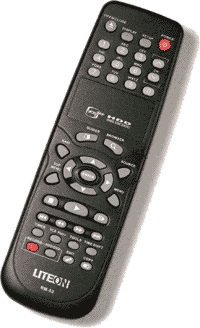Lite-On LVW-5045 DVD Recorder Page 2
| PLUS •Records in same way to four formats. •Bit-perfect high-speed dubbing. •Fine image and sound quality. MINUS •Takes practice to cue editing points. •Awkward remote control. •No electronic program guide. •No IR emitter for cable/satellite box. |
There is a workaround if you're only looking to make a keeper disc on a format other than DVD+RW and don't need to re-edit it later. Just do all of your editing on the hard drive. Once you're satisfied with the final cut and burn your keeper DVD, those commercials will be gone for good - chapters hidden on the edited hard-drive recording disappear altogether when you dub from the hard drive to DVD.
It's easy to insert or clear chapter markers or to designate a chapter as "hidden" - just push a button - but it's tricky to cue up the recorder to the precise point where you want a chapter to start or end. Slow-motion playback is not available during editing, and frame-by-frame advance is provided only in the forward direction.
 Complicating things is that chapter markers are inserted a fraction of a second before the point in the program at which you paused to hit the Insert Chapter button. So your first attempt at removing commercials might lop off a fraction of a second of the preceding program segment and leave the last frames of the commercial before the start of the next segment.
Complicating things is that chapter markers are inserted a fraction of a second before the point in the program at which you paused to hit the Insert Chapter button. So your first attempt at removing commercials might lop off a fraction of a second of the preceding program segment and leave the last frames of the commercial before the start of the next segment.
The lack of cueing precision in reverse is the kind of thing that may be addressed by downloadable firmware updates, as provided for on the Lite-On Web site. What a firmware update can't address is the awkwardness of the remote control, whose main buttons are too closely spaced and barely protrude above the surface, making them hard to navigate by touch.
DUBBING On the upside, the high-speed dubbing from HDR to DVD was a real treat. Lite-On makes no claims about speed, but I was able to burn a 1-hour episode of Revelations - originally recorded onto the hard disk in the 1-hour HQ (high-quality) mode - to each of the DVD formats in about 18 minutes. If I'd used the lower-quality 3-hour LP mode for the original recording, the dubbing time would have decreased to about 6 minutes for a 1-hour program. Video quality was excellent in the high-quality mode and at slower speeds was on par with what we've come to expect from DVD recorders (see "in the lab").
High-speed dubbing does have a few restrictions, however. The original hard-disk recording must fit on the DVD you're dubbing it to. The deck doesn't record on dual-layer discs, you can't change recording modes during a dub, and there's no real-time, normal-speed dubbing between hard disk and DVD as found on other DVD/HDR combos. You also need high-speed DVD blanks. My speed tests were obtained with 8x and 4x discs.
A great feature is that the high-speed dubbing also works in the other direction, from DVD to the HDR - and a bit faster, too. Not only that, but the high-speed dubbing process is bit-perfect! Everything playable gets transferred to the hard drive - menus, soundtracks, subtitles, camera angles, whatever. I could play the hard-disk files for the titles I copied as if the discs were still in the drawer.
Of course, the catch this time is that copy-protected DVDs can't be dubbed, period. But homegrown DVD productions and the occasional unprotected title transfer just fine. Once on the hard disk, they can be cued faster and more smoothly than on DVD. And while you can't edit DVD-to-HDR dubs, they can be dubbed onto blank DVDs, also with bit-perfect accuracy.
BOTTOM LINE Except for the predictable bother of timer recording without an electronic program guide, the LVW-5045 was a breeze to use. I even got used to its peculiarities of cueing - probably because I was so taken by its ability to do high-speed dubbing with no loss of quality. It's a fine DVD recorder, but an even better dubbing machine.
- Log in or register to post comments




































































